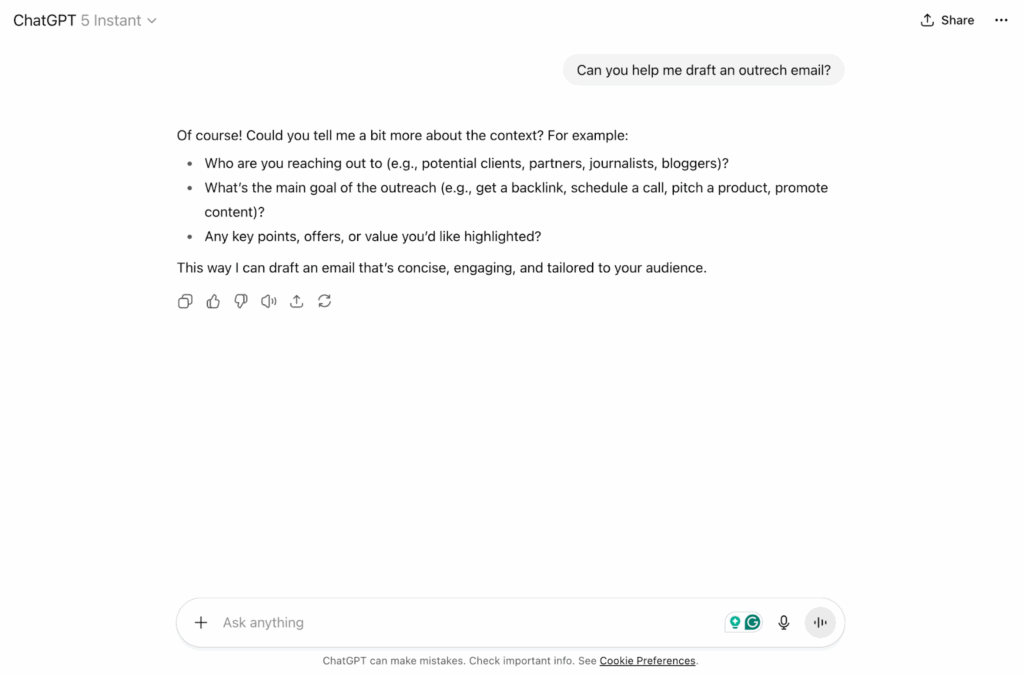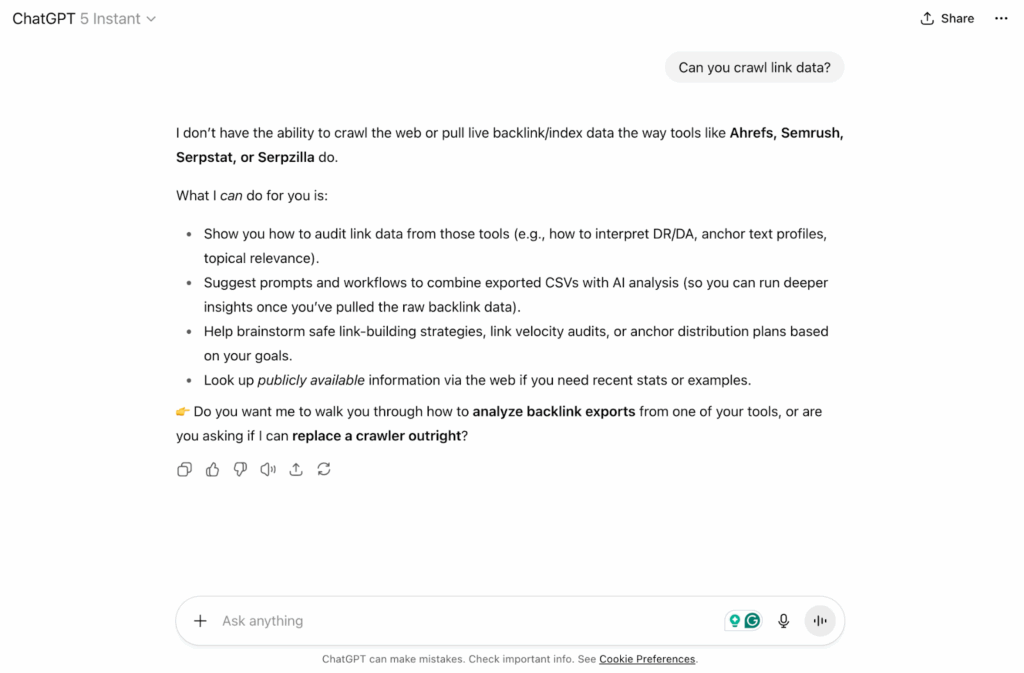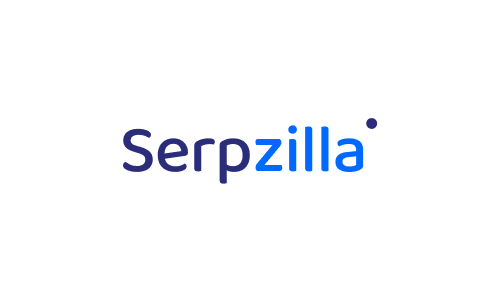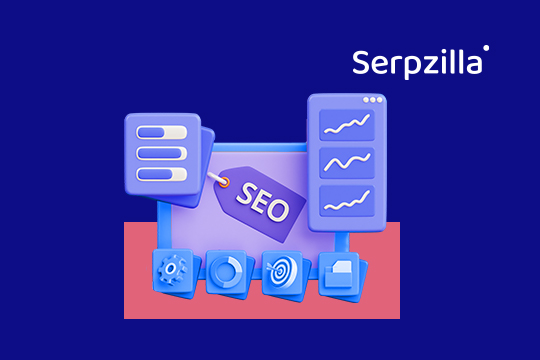The way we earn backlinks is not what it used to be. Site owners and editors don’t respond to cookie-cutter pitches anymore. They expect context, personalization, and ideas that add value to their audience. That’s why using ChatGPT for link building is becoming a core skill for SEO teams. It won’t magically build backlinks for you, but it can help you discover angles you hadn’t considered, draft strong pitches, and even repurpose competitor insights into effective AI SEO strategies. Used well, it saves time and makes your link building sharper.
This article walks through 11 practical ChatGPT prompts for SEO you can test right away. Plus, we’ll cover how to combine ChatGPT with dedicated AI link building tools 2025 (like Serpzilla, Ahrefs, or SEMrush) to scale your campaigns.
Why Use ChatGPT for Link Building in 2025?
Who wouldn’t want to work faster, cut down on the repetitive parts of outreach, and have fresh ideas on demand? That’s what ChatGPT brings to link building. It doesn’t replace your tools or professional network, but it can speed up lots of processes.
Where ChatGPT fits in modern SEO outreach
ChatGPT acts like a second brain. It helps you come up with content snippets, anchor text ideas, or new outreach angles instantly. Instead of staring at a blank screen, you start with something you can refine and tweak.
Where ChatGPT truly adds value
- Drafting emails for various target audiences (bloggers, journalists, niche site owners)
- Suggesting anchor text for a natural profile
- Coming up with ideas for linkable assets like calculators, infographics, or stat roundups
- Reworking a paragraph so your link slides in smoothly without breaking the content flow

In short, ChatGPT is a creativity engine that supports the heavy lifting your SEO platforms do.
What ChatGPT can’t do
While ChatGPT is a great creative partner, it obviously has limits. It won’t replace your data stack or the human side of link outreach. For example, ChatGPT cannot:
- Act as a backlink database. It doesn’t keep a live index of who links where.
- Crawl or update link data. You’ll need Ahrefs, Semrush, or similar tools for that.
- Negotiate placements with site owners. That still requires human effort or a platform like Serpzilla.

Bottom line: ChatGPT is not the scout or the deal-maker (at least not yet). You’ll still need dedicated AI link building software and human interaction to turn ideas into working backlinks.
11 Actionable ChatGPT Prompts for Link Building
Here are 11 actionable ways to use link building with ChatGPT, with ready-to-run prompt examples.
1. Find listicles that match your brand and niche
Listicles are nothing short of excellent when it comes to backlink opportunities. They rank for years and get updated regularly, plus people love them because they’re easy to scan. ChatGPT can help you identify categories where your brand would slot in naturally.
A prompt to try:
“Suggest 20 listicle titles in the format ‘Top [X] Tools for [industry or task]’ where [my product/service] would fit. Focus on opportunities relevant to [target audience].”
Next step: Drop those titles into Google or Ahrefs to find real ranking pages, then build your outreach list.
2. Generate ready-to-insert listicle entries
You don’t need to stop at asking bloggers to add you. Make it easy for them by sending a polished blurb! ChatGPT can write the exact paragraph they’d be able to paste into their article right away. The tool is great at
A prompt to try:
“Write an 80-word product blurb for [product/service]. Emphasize one major benefit, one unique feature, and close with a natural yet encouraging call-to-action. Style it like a listicle entry. Use a [type of writing style] style and be reader-friendly.”
Why it works: Editors value time. If you save them work, your odds of landing the link skyrocket.
3. Reverse-engineer competitor backlinks
Competitor analysis is always a big deal in SEO, and AI can help you here, too. Use a hybrid workflow here: pull backlink lists via Ahrefs or Semrush, then let ChatGPT help you sort through the data. It can group links by type, find relevant patterns, and highlight the best SEO opportunities.
A prompt to try:
“Here’s a list of competitor backlinks: [paste from a SEO tool]. Cluster them into categories (guest posts, resource pages, PR mentions, etc.) and suggest three outreach strategies for each category.”
Pro tip: For execution at scale, platforms like Serpzilla let you filter, analyze, and secure placements directly — something ChatGPT alone can’t do. You can move from a handful of manual outreach emails to managing hundreds of opportunities in one place, while still keeping control over budgets, niches, and anchor text settings.
4. Uncover aged domains that AI still “remembers”
ChatGPT is trained on data going back years. This means it can still find websites, blogs, or communities that don’t show up in the current search. Many links often get abandoned when sites change owners, stop updating, or shift focus to new topics, even though the old pages still carry authority. Those “forgotten” sites can be your backlink opportunities.
A prompt to try:
“List websites, blogs, or online communities that were popular in [industry] around 2015–2019. Suggest possible outreach hooks for reconnecting with them today.”
This trick works surprisingly well for niches where older domains still carry authority. For instance, finance blogs, health information portals, or long-running tech forums that may not publish often anymore but still rank well.
5. Spot high-visibility Reddit and Quora threads
Evergreen Q&A threads can drive referral traffic for years if your link fits naturally. ChatGPT can surface ideas on which threads you should target and even draft context-aware responses.
A prompt to try:
“Identify 20 evergreen Reddit or Quora threads about [topic/niche] that attract ongoing engagement. Suggest how I could reference [my resource] in a way that adds value to the discussion.”
Pro tip: Before engaging and dropping your link, use ChatGPT to analyze the thread tone and suggest phrasing that matches the community style. A well-chose tone increases trust and makes your contribution feel like genuine participation instead of a promotion that users tend to skip.
6. Build a link-worthy anchor text strategy
Over‑optimized or repetitive anchors look unnatural to search engines and can harm rankings. ChatGPT can suggest natural variations for you and even organize them by intent to help balance optimization with authenticity.
A prompt to try:
“Generate 20 anchor text variations for the keyword [primary keyword]. Include branded, partial match, generic, and long-tail options. Group them by commercial, informational, and navigational intent. Aim to sound natural.”
This strategy helps diversify your profile, aligns anchors with searcher intent, and reduces the footprint that often comes from over-optimized anchors. By experimenting with variations, you’ll spot phrases your audience naturally uses — these are the insights that can feed back into your content strategy as well as your link building.
7. Figure out the best context for link insertion
Sometimes you already have a relationship with a blogger, but need the link to fit smoothly. ChatGPT can rework the existing copy to make room for your link without disrupting flow, and even give you multiple options to test.
A prompt to try:
“Here’s a paragraph: [paste]. Rewrite it three different ways so that it naturally includes a reference to [my resource/link], keeping the tone and readability intact.”
This avoids the awkward “shoehorned link” problem editors hate and gives you a range of insertion opportunities to offer.
8. Brainstorm linkable assets in seconds
Great backlinks come from great assets, whether that’s an infographic, calculator, or original survey. Such assets work because they offer something people want to reference: data to cite, visuals to embed, or tools that solve a real problem. When your asset makes someone else’s content stronger, they’re far more likely to link back. ChatGPT can suggest great ideas for what to build and outline the content or mockup structure instantly. It can also offer link bait ideas to try out.
A prompt to try:
“Suggest 10 linkable assets I could create for [niche]. For each, explain what makes it attractive to bloggers and which keywords or audiences it would target. Show me some references.”
Next step: Once you’ve got a shortlist, ask ChatGPT to draft the outline or wireframe so your design or content team has a head start.
9. Create personalized outreach emails
You know that one pitch won’t fit every audience. A journalist wants something different from a niche blogger. ChatGPT can tailor outreach in different voices and add personalization cues, saving you tons of time on crafting emails manually.
A prompt to try:
“Write three outreach email drafts about [asset or pitch]. Create one for a journalist (formal, data-driven, includes a stat), one for a blogger (friendly, conversational, includes a compliment on a recent post), and one for a community site owner (helpful, collaborative tone, emphasizes shared audience). Keep them under 150 words each.”
This way, you’re sending relevant, tone-matched pitches instead of generic spam.
Pro tip: You can also ask ChatGPT to highlight personalization triggers like a recent article the blogger wrote or a stat the journalist cited. Your outreach will feel more authentic and show you actually did your homework.
10. Find unique digital PR angles
Backlinks from major publications usually come via digital PR angles, including unique research, surveys, or seasonal hooks. ChatGPT can help brainstorm these faster and tie them to industry trends.
A prompt to try:
“Suggest 10 digital PR campaign ideas for [industry]. Include survey questions, viral hooks, trending seasonal tie-ins, and data points journalists could cite.”
Even if only one idea works out in the end, it can yield dozens of high-authority backlinks. Down the road, you can also ask ChatGPT to put together press release outlines or survey questions to run for the chosen campaign.
11. Generate guest post titles that editors will accept
Pitching guest posts gets easier when your titles match what a site already publishes. ChatGPT is good at mimicking a publication’s style, analyzing tone, and proposing ideas that fit trending SEO topics.
A prompt to try:
“Here are five recent article titles from [target site]: [insert]. Suggest 10 new guest post ideas in the same style and tone, but focused on [my topic/keyword]. Highlight which ideas would attract search traffic in 2025.”
Editors are more likely to give an enthusiastic yes to your pitches when the title sounds like it belongs on their site, with topics readers are actively searching for.
Bonus: Ready-to-use GPT chats focused on link building
Here are a couple of pre-built ChatGPT conversations you can plug into right away:
These chats are solid starting points that will help you ease into the AI routine before you refine your own prompts. You can go straight into experimenting with internal linking or outreach ideas — the chats are trained to do just that. They’re also updated with community-tested workflows, giving you ideas on what has already worked for others. Take these insights and adapt them to your own campaigns
FAQ: ChatGPT for Link Building
Find the answers to the most common questions about AI-powered link building with ChatGPT.
Can ChatGPT build backlinks fully automatically?
No, ChatGPT can’t secure backlinks alone. It doesn’t negotiate with publishers, manage contracts, or place links on the right pages. However, it can handle the creative side like writing outreach emails and brainstorming effective PR hooks. That’s why you still need tools like Serpzilla to find placements. Don’t forget about the human touch and professional connections — these still matter as well.
Can I use ChatGPT to automate outreach?
You can use ChatGPT to speed it up, but remember that full automation is risky. Yes, AI can generate dozens of personalized emails, adjust tone, and come up with follow-up communication assets. But if all you do is blast AI-generated emails at scale, you’ll probably trigger spam filters — a recipe for damaging your brand’s reputation. The best approach is hybrid: let ChatGPT prepare drafts, then refine them before sending. That way, you can scale without sacrificing quality and brand consistency.
Does AI-generated content still attract backlinks?
Yes, when it’s authentic and useful. AI can help create assets like infographics, data roundups, calculators, or whitepapers that provide value people and sites want to reference. Those kinds of resources attract organic backlinks. Yet, experience shows that generic AI blog posts without depth rarely perform well (if at all). Editors and journalists look for credibility, originality, and data. AI can absolutely produce link-worthy content, but quality control is a non-negotiable here.
Final Thoughts
ChatGPT is no match to your expertise or dedicated tools for link building. However, it’s a fantastic tool for speeding up lots of manual processes and enhancing your efficiency.
Use ChatGPT as a brainstorming and drafting assistant. Try these prompts today to upgrade your outreach and link acquisition strategy. Then bring in SEO tools like Serpzilla for validation and application, and don’t forget to refine it all with your creative touch.








